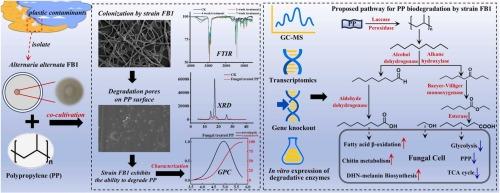A marine fungus Alternaria alternata FB1 degrades polypropylene
IF 11.3
1区 环境科学与生态学
Q1 ENGINEERING, ENVIRONMENTAL
引用次数: 0
Abstract
Polypropylene (PP), a widely used plastic, is difficult to recycle, creating environmental challenges. Despite some microorganisms having been reported to degrade PP, their capabilities are limited and generally require pretreatment. In this study, we report a marine fungus, Alternaria alternata FB1, that degrades untreated pure PP. Integrated assays demonstrated the formation of hydroxyl and carbonyl functional groups, a 90 % reduction in crystallization peak height, and a 65 % decrease in weight-average molecular weight following fungal degradation. (E)-octadec-9-ene and nonadec-1-ene were identified as the main degradation products of PP by strain FB1. Transcriptomic analysis identified several potential PP-degrading enzymes, including a Baeyer-Villiger monooxygenase and a KatG catalase-peroxidase, whose activities were confirmed through in vitro assays. By combining gene knockout experiments to verify the functions of key degradation enzymes in vivo and transcriptomic analyses to predict the metabolic pathway of degradation products in strain FB1, we propose a comprehensive pathway for fungal degradation and utilization of PP for the first time. Our study offers significant potential for future research and industrial biodegradation applications.

海洋真菌alternnaria alternata FB1降解聚丙烯
聚丙烯(PP)是一种广泛使用的塑料,很难回收,给环境带来了挑战。尽管有报道称一些微生物可以降解PP,但它们的能力有限,通常需要预处理。在这项研究中,我们报道了一种海洋真菌alternnaria alternata FB1,它可以降解未经处理的纯PP。综合分析表明,在真菌降解后,羟基和羰基官能团的形成,结晶峰高度降低了90% %,重量平均分子量降低了65% %。菌株FB1对PP的主要降解产物为(E)-十八烯-9-烯和壬烯-1-烯。转录组学分析鉴定出几种潜在的pp降解酶,包括Baeyer-Villiger单加氧酶和KatG过氧化氢酶过氧化物酶,其活性通过体外实验得到证实。通过基因敲除实验验证关键降解酶在体内的功能,结合转录组学分析预测菌株FB1降解产物的代谢途径,首次提出了真菌降解和利用PP的综合途径。我们的研究为未来的研究和工业生物降解应用提供了巨大的潜力。
本文章由计算机程序翻译,如有差异,请以英文原文为准。
求助全文
约1分钟内获得全文
求助全文
来源期刊

Journal of Hazardous Materials
工程技术-工程:环境
CiteScore
25.40
自引率
5.90%
发文量
3059
审稿时长
58 days
期刊介绍:
The Journal of Hazardous Materials serves as a global platform for promoting cutting-edge research in the field of Environmental Science and Engineering. Our publication features a wide range of articles, including full-length research papers, review articles, and perspectives, with the aim of enhancing our understanding of the dangers and risks associated with various materials concerning public health and the environment. It is important to note that the term "environmental contaminants" refers specifically to substances that pose hazardous effects through contamination, while excluding those that do not have such impacts on the environment or human health. Moreover, we emphasize the distinction between wastes and hazardous materials in order to provide further clarity on the scope of the journal. We have a keen interest in exploring specific compounds and microbial agents that have adverse effects on the environment.
 求助内容:
求助内容: 应助结果提醒方式:
应助结果提醒方式:


